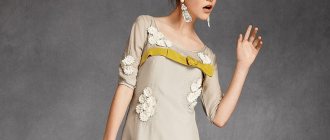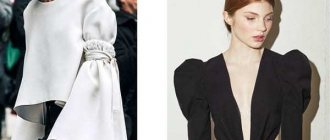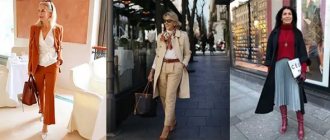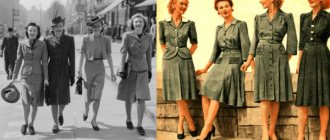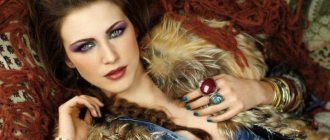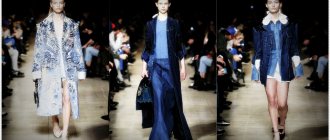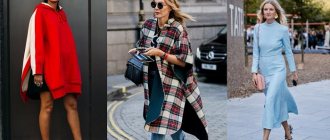Fashionable women's clothing of the 30s
In the 30s Factory-made clothing (what we now call “ready-to-wear”) is becoming especially popular. A mass-produced product costs much less than a custom-made product, which is very important during an economic downturn.
Inexpensive materials have become more widespread. “Coarse” (“peasant”) fabrics, as well as cotton, are in fashion. Textured fabrics are becoming trendy. “The rougher, the more fashionable” is one of the main criteria that guided the selection of fabrics for coats, daytime casual dresses, and skirts.
Fabrics used in the 1930s:
- cotton for casual dresses;
- silk or viscose crepe for evening dresses;
- thin viscose for blouses and summer evening dresses;
- linen for summer suits and dresses;
- wool for winter suits and outerwear;
- tweed or viscose corduroy for autumn-winter dresses;
- silky satin, lace, velvet and taffeta for evening dresses.
Fabric colors that were in fashion in the 30s:
| During the spring-summer period | During the cold season | All year round |
|
|
|
In addition, new colors for fashion during the Great Depression appeared - peach and turquoise, which did not exist in the 20s.
Main fashion trends of the 30s.
In the 20s Very loose clothing with a low waist and knee length was in fashion, giving the figure a square outline. By 1933, it had completely disappeared, and in its place came a more modest and form-fitting style with an emphasized femininity.
Now the following were important for a fashionable image:
- broad shoulders
- high waist;
- tight hips;
- hem length to mid-calf or to the floor.
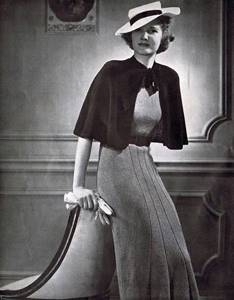
The silhouette imposed by fashion trends was not at all realistic. Magazines and advertisements depicted women three times taller and thinner than any real woman. However, fashionistas strove for the ideal, in which they were partially helped by underwear, which formed the desired shape.
Of course, the fashion of the 30s. last century was modified, but among the main trends that persisted throughout the entire decade are:
- midi-length dresses with puffy sleeves, large yokes and collars, and a belt at the waist;
- all this time, evening dresses with an open back, with long oblique inserts and sleeveless remained in fashion;
- high-waisted sailor pants and wide-leg beach pajamas;
- shorts that look like skirts, striped knitted shirts as sportswear;
- slouch hats (hats with lowered brims), slanted hats, berets;
- fur collar of a winter coat;
- Oxford shoes with perforated details, shoes with T-strap.
Dresses
The figures of most women did not correspond to the fashionable ideal, therefore, in dress styles, shoulders were increased due to special shoulder pads, puffed sleeves, large collars, and frills, which made the waist and hips appear smaller.
Homemade
House dresses were most often made from practical and durable cotton percale (percale is a high-strength cotton fabric made from untwisted threads) with bright, bold prints, and their styles corresponded to fashion trends.
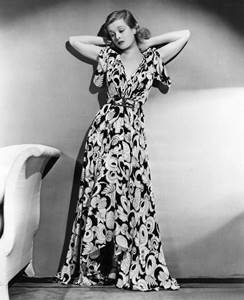
The most popular was a reversible wrap house dress called a "hooverette". It was like a robe with a deep wrap, a tie at the waist, and a sporty sleeve (or other comfortable shaped sleeve).
The versatility of the style was that the front shelves could be swapped (that is, the right one could be wrapped over the left one or vice versa), which made it possible to hide dirty stains that appeared during housework.
Practical and washable, the hooverette was the ideal everyday dress that was in keeping with the style of the thirties.
Day (everyday) dresses
Day dresses were intended for leaving the house on business (for example, shopping). They were usually made from silk or viscose crepe. The styles corresponded to the classic silhouette of the 30s: puffy sleeves, a belted waistline, large collars.
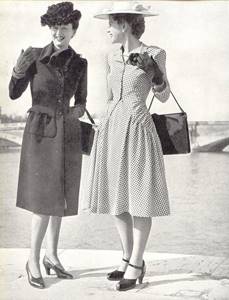
To make day dresses more attractive, they were decorated with more details.
For this we used:
- regular embroidery;
- trapunto (trapunto is voluminous embroidery);
- decorative buttons;
- appliqué;
- hemstitch;
- assemblies;
- ruffles;
- bows;
- artificial flower trim;
- metal rivets;
- decorative pins;
- lace, pleats and various woven details.
The emphasis was on the upper part of the dress, so the collar, bodice and sleeves were decorated. Bottoms of dresses and skirts in the 30s. were simple and varied in folds and seam styles. The colors chosen for daytime models were, as a rule, monochromatic and muted.
Characteristics of autumn were:
- plum;
- brown;
- royal blue;
- emerald green;
- gold;
- gray and black.
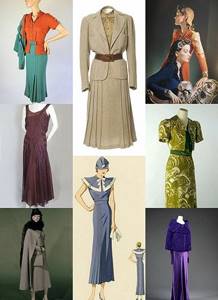
The spring palette included:
- pink;
- creamy yellow;
- peach;
- sky blue;
- orange;
- brown;
- white;
- orchid, rose and medium blue.
Evening dresses (dresses for various events)
Evening dresses in the 1930s were long and sexy. They were often worn with fur capes. For tailoring, well-fitting fabrics were used. Chiffon, silk, crepe de Chine, and satin were especially popular. Fashionable evening dresses emphasized all the curves of the female figure up to mid-thigh, and flared elegantly below.
At the front, the hem almost touched the floor, and at the back it often had a small train. Many dresses were decorated with small groups of beaded flowers or rhinestones around the neckline. If at first models with puffy sleeves were in trend, then later they began to wear sleeveless styles and with a deep cutout at the back. The backless evening dress is the most trendy model of the 1930s.

Slip dresses were made from light flowing fabric, which was often gathered at the shoulder with a decorative brooch.
Just like in the late 20s. Art Deco style dresses remained trendy. Designers of the 30s took their inspiration from the images of Greek and Egyptian goddesses, whose outfits were formed by extensive drapery. Despite the fact that the dresses were sleeveless and exposed their backs, they did not look too revealing.
Wedding Dresses
The wedding dresses looked different. These were silk or satin floor-length models with a fishtail train. They had a modest shallow neckline and long sleeves. The look was complemented by airy veils decorated with lace.
Pants and skirts
Some women wore trousers before the Great Depression, but not until the 1930s. It has become possible in some situations, for example, while playing sports or relaxing on the beach, to wear this item of clothing in public.
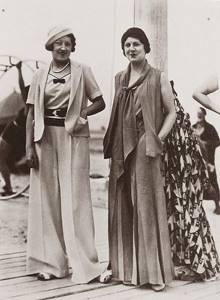
Sports pants and shorts were worn for playing tennis, hiking, outdoor recreation, skiing and skating. Also, such clothing was acceptable when watching sports competitions.
The trousers were wide cut with a pleat at the front. For example, culottes (very wide, flowy and high-waisted) looked like a skirt if the woman stood still. This piece of outerwear for the warm season was usually sewn from durable cotton fabric, such as twill; for the winter version, wool was chosen.
It was fashionable and modern to appear on the beach in beach pajamas. They were not very different from today's models and looked like extreme-wide palazzo pants (palazzo is a style in which the pants widen from the waist or upper thigh) with a sleeveless top attached to them.
These clothes were very comfortable. To sew it, thin fabrics in bold geometric patterns were most often chosen. But still, a skirt remained a more common option. Its length is in the early 30s. reached the ankle. In the middle of the decade, frilled skirts were replaced by long and straight ones, which by the 40s. gradually turned into flared ones with a length just below the knee.
The skirts had:
- high waist;
- slightly flared hem;
- fitted, but not too tight to the figure.
Blouses, shirts
In addition to skirts and trousers, there were shirts, jackets, blouses, and sweaters. Due to its simplicity and comfort, the cotton button-down blouse with a floral print and puff sleeves was very popular. Due to the fact that high waistlines were in fashion in the 30s, blouses were short in length and fitted tightly to the waist, which made it possible to wear high-waisted skirts and trousers.
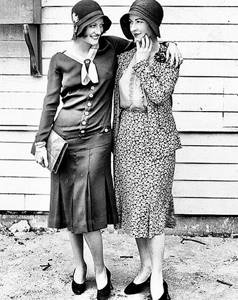
The shallow neckline was decorated with small collars of various shapes. Blouses were decorated with such details as pintucks, folds, frills, and beautiful buttons, which gave the product additional aesthetics.
Women usually covered deeper necklines with scarves or small light scarves, which served as an additional touch to the look. They were tied around the neck, and the edges were tucked under the blouse.
The simplest blouse style was a button-up shirt with a stand-up collar. It could be either elegant or casual, and went well with skirts and trousers.
The shirts also differed in color. Popular patterns in the 30s. there were checks, stripes, polka dots, paisley (paisley is a fancy pattern shaped like a drop with many small details). In stores, printed blouses were often sold with a jacket, lined in the same material as the blouse, and a matching skirt.
Satin, silk, lace, and organdy were used to sew elegant blouses. Wrap styles had long batwing and bishop sleeves. To give the thin airy product volume in the shoulders and chest, the model was complemented with bows, frills, ruffles, shirtfronts, and capes. Many blouses had a belt.
Outerwear
Outerwear was represented by coats, raincoats, and jackets.
Coat
The coats repeated the silhouette of fashionable dresses: high narrowed waist, wide shoulders, voluminous sleeves. The style was complemented by large collars or wide lapels. Many coats, especially winter ones, had detachable fur collars and belts. The clasp was on the front or side.

For sewing, wool of rich colors was used: green, medium blue, wine, brown, cream.
Cloaks
In the 30s The cape and trench coat were popular. Raincoats were made from wool or cotton rubberized fabric. This impregnation made the raincoats waterproof. Most raincoats did not have sleeves or arm holes. Some models had hoods, others came with round collars.
A fashionable novelty of that time was translucent raincoats with sleeves, loved by women because they did not hide their clothes underneath. They were often accompanied by transparent bags with a handle or envelope bags that could be hidden from the rain under a raincoat.
By the end of the decade (when the economy began to recover), women began to prefer raincoats, which were similar to fashionable coats.
Shoes and accessories
The fashion of the 1930s for women living in the Great Depression required special skills that made it possible to turn a simple dress or suit into original clothing. During the difficult economic situation, a fashionable image was created through accessories: handbags, gloves, belts, hats and jewelry.
Shoes
In the 1930s Women's shoes came in a wide variety of styles, but mid-heeled and lace-up Oxfords remained the most popular (in difficult times, the emphasis was on comfort and durability).
Shoes with cutouts, T-straps and ankle straps, shoes with Cuban, Spanish, built-in heels 2-6 cm high were in fashion. Sandals and even sports shoes also had a small flat heel.
Unique characteristics of Stagnation-era footwear were cutouts and brogues (small holes that create complex patterns on the body of the shoe). It was during this period that Oxfords acquired a higher heel.
Pumps of that time were made of patent leather or suede, had a square heel and were decorated with various details, such as lacing, bows, and figured stitching. Introduced back in the 1920s, T-strap shoes became extremely popular in the next decade for both casual and formal wear.
For the cold season, they usually chose brown or black; in summer they wore white. But the trend was two-tone shoes. This fashion extended to regular and sports shoes. Evening shoe models were usually high-heeled pumps, decorated with a gold or silver strap. In the winter months they wore fur boots and rain galoshes.
Hats
Hats and bonnets have become the main elements decorating the entire ensemble. In the 30s They wore hats of different styles. Cloche hats and berets have remained in fashion since the last decade. However, the cloche has changed somewhat: its brim has become wider.
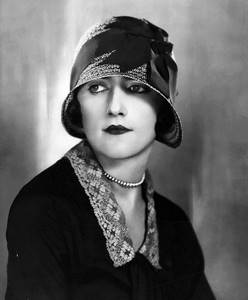
Small hats worn slanted were extremely popular. Often the main accent was a bird's feather. By the late 1930s, men's style fedora hats were already dominant. Also, beautiful scarves tied on the head were in fashion as headdresses. In summer they wore wide-brimmed straw hats.
Bags
During the Great Depression, bags, as a rule, were small and flat (clutches, bags). If evening bags were decorated, for example, with rhinestones, then day bags looked more modest. By the end of the 30s. The dimensions of this accessory gradually increased and handles appeared.
Gloves
Gloves were appropriate with both everyday and evening dresses. For sports and special occasions they continued to wear leather ones, but for everyday wear they most often used fabric gloves, which were more affordable and practical. They were made from viscose and cotton. They were thin, washed well and came in a wide range of colors.
The length of the daytime models reached the middle of the forearm. They were made from fabric, crocheted lace, and soft leather. Less popular, but more affordable, gloves were shorter, made of suede or cotton fabric, and had minimal embellishment.
In the summer, they usually wore homemade knitted white gloves, which were affordable. They tried to combine them into one set with knitted hats, wallets, and belts. At the same time, they matched the color of other accessories.
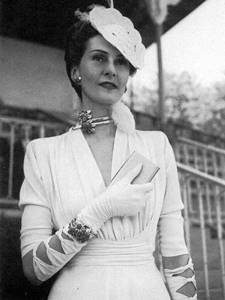
Dressy models had wide, decorated cuffs that fastened at the wrists. If the fastener did not have a decorative function, it was replaced with an elastic band. The design of the cuffs was as thoughtful as the details of dresses, handbags or shoes. Bows, embroideries, buttons, tucks turned gloves into a bright detail of a fashionable look.
They rarely wore evening dresses, but they also wore elbow-length gloves. However, in the 30s. Evening style still involved open arms.
Decorations
The fashion of the 1930s for women with limited means relied mainly on the ability to make jewelry themselves. A small bouquet of flowers was the perfect brooch for a lady's suit.
Rhinestones, multi-colored glass beads, and artificial pearls were several times cheaper than natural stones. This made them an excellent material for making hairpins, pins, earrings, bracelets and evening necklaces.
Hair and makeup
A woman should always be attractive. Despite the economic depression during this period, the demand for cosmetics doubled. High thin eyebrows came into fashion, eyes were emphasized with dark eyelashes and shiny shadows. The lips were painted in soft pink tones to harmonize with the peach blush.
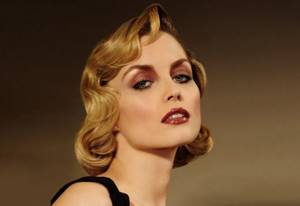
Some women continued to wear long hair, but short hair became fashionable. They were styled using rag curlers or special Marcel Iron curling irons were used to create deep waves.
Makeup
In the thirties, make-up began to be created according to a special principle. Eyebrows were plucked in the form of the thinnest threads possible. Many fashionistas decided to shave them off and drew the desired shape with a pencil.
When creating makeup, shadows were used in purple, blue, brown, gray and even green. When creating an evening look, shimmering options have become appropriate. The daytime look meant the use of matte blush.
Blush was chosen raspberry or pink. They were carefully shaded. Leaving a bright spot of blush on the face was no longer acceptable.
The look was made as open as possible through the use of mascara. When going to a party, women used false eyelashes. Particular attention was paid to the eyeliner. The line was made graceful and as thin as possible. Thanks to this, the image turned out to be as natural as possible. The lips were painted as clearly as possible. Their outline did not decrease.
Of course, in the thirties fashion was far from what it is now. True, even modern fashionistas often create images in this style. They turn out incredibly elegant and feminine. In order to choose a suitable ensemble, you just need to familiarize yourself with all the fashion trends of that time. After studying this information, creating the perfect image will not be difficult.
Features of the style of the 30s among women in different countries
At all times, fashion in different countries has had its own characteristics. It depends on the mentality of a particular people, as well as the economic and political situation in the state. 30s were no exception.
USSR
Fashion of the 30s women living in the USSR relied on the images of heroines of Soviet cinema. At first, low-waisted Charleston-style dresses were popular. Various embroideries and appliqués served as decoration.
Then this fashion goes away and is replaced by straight skirts made of soldier's cloth, blouses made of cotton and dresses made of canvas. A symbolic element of women's clothing of that time can be called a red scarf as a headdress.
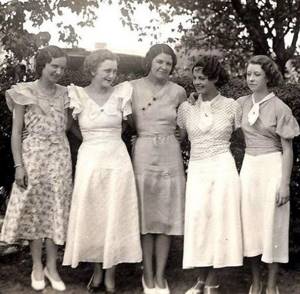
Imitating movie heroines, Soviet women plucked their eyebrows and dyed their hair blonde. Both long braids, which took the form of intricate baskets, and short haircuts were in fashion.
Europe
Practicality and restraint are the main characteristics of European fashion during the period of stagnation. The fashion of European countries is characterized by wide shoulders, narrow hips, large collars, neck scarves, headscarves and midi length (that is, from the middle of the shin to the knee).
During this period, such a novelty appeared as the bias cut, widely popularized by the Frenchwoman Madeleine Vionnet. It allowed the dress to flow and at the same time fit snugly to the figure.
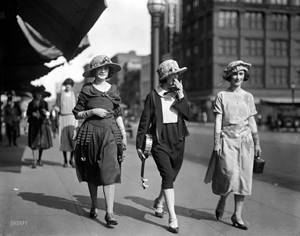
The fashion of the 1930s for a woman living in a country that propagated fascist ideology (Italy, Spain, Germany) became the subject of political agitation in the pre-war years.
For example, the trend here was the uniform of the German women's club "Bund Deutscher Mädchen" ("Union of German Girls") and Alpine costumes, which also corresponded to the tastes of National Socialist Germany.
Asia
Fashion in Asian countries has been extremely conservative until recently.
It has always (including in the 30s) been characterized by:
- clear lines and precise proportions;
- multilayer;
- straight, non-tight silhouette, which in some models widens downwards;
- long, one-piece sleeves (raglan, “bat” type);
- high collar and lack of neckline;
- Belts or air loops were used as fasteners;
- characteristic designs on the fabric: hieroglyphs, dragons, sakura, bamboo, butterflies and other elements characteristic of Asian culture.
America
American fashion 20–30 developed in the Chicago style. These are hip-hugging shortened (length just below the knees) skirts, which by the end of the decade became even shorter, a defiantly emphasized waistline and blouses with a deep neckline.

Some women preferred to wear tuxedos and men's hats. The look was completed with a tie.
Features of women's fashion in the 1930s
The line between social status and gender is gradually disappearing. The fashion of the 1920-1930s gives birth to a unisex style, which was then called “la garconne”. Women have learned to drive cars, demonstratively smoke a lot, cut their hair short, and paint their lips with bright red lipstick. Golf and tennis became the favorite sports of many fashionistas, and they spent their nights in dance clubs. In those days, stylish girls wore clothes that hid their figure: baggy clothes, miniskirts, men's cut suits.
A figure devoid of all femininity was considered fashionable: lack of breasts, narrow hips, angular shapes. Clothing of those times was designed to carefully hide women's curves. Ladies who were not lucky enough to have a boyish silhouette were forced to use corsets and graces that visually flattened the figure.
[adv]
Slender young ladies could afford to wear bras and garter belts. With short dresses and skirts, one should wear pantaloons with elastic bands near the knee, as well as an underdress with straps.
With the advent of the next decade, figure-hugging long skirts and dresses come into fashion. Both in art and in everyday life, functionalism is a favorite. Fashion also undergoes changes under its influence. 1930 fashion is characterized by bias cut dresses that beautifully outline the figure. A deep neckline and straps also look impressive. The aristocracy could afford to throw fur capes over open dresses.
Ladies of those times wore suits that were tailored strictly to their figure. There had to be a belt at the waist, and for additional attention to the figure, scarves and shawls were worn on top, which were tied with lush bows.
Examples of fashionable images
Fashion of the 30s implied variability, so women sought to create their own fashionable images by combining various items of clothing in one ensemble.
Winter
For winter fashion, the trend was cuffed ski pants and a jacket. Woolen or flannel trousers, but without cuffs, appeared in the late 30s. Then it became fashionable to combine them with thick “ski” sweaters or flannel shirts in a men’s style.
This set was paired with a belted Mackinaw style jacket or a cropped bomber jacket. Knitted winter hats, scarves, mittens and a pair of laced winter boots became integral elements of this style.
Spring-autumn
In the 30s For cool weather, one of the favorite looks was the combination of a fitted blazer, worn over a dress or a set consisting of a skirt and blouse. Unlike a suit, a blazer could be of any color, harmoniously combined with a dress or skirt. Often the blazer was replaced with a cropped leather jacket in various colors.
Summer
Wide-leg sailor trousers in white or blue with contrasting buttons were the best trousers of the 1930s. They went great with casual striped knit t-shirts or polo shirts.
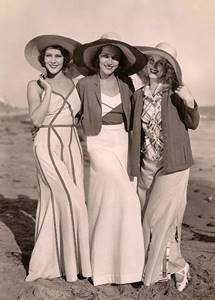
The famous actresses of old Hollywood still remain a symbol of glamor. Their style is a role model that many famous fashion designers have been following for decades. Therefore, many styles (including evening dresses) have their roots in the distant 30s.
Vintage models inspire not only ordinary women, but also modern Hollywood stars, who often appear on the red carpet in stylish looks from the Great Depression period.
Author: Irina Zhuravka
